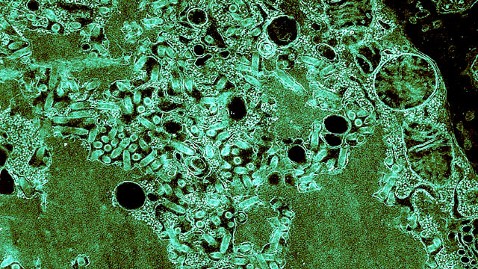When Microorganisms Control the Mind

A microscopic image of the rabies virus. (Image credit: BSIP/UIG Via Getty Images)
Reported by Dr. Lauren Browne:
By the time famed Victorian artist Louis Wain was committed to the pauper ward of Springfield Mental Hospital in South London in 1924, he had painted and sketched thousands of cats.
His early works depicted humorous wide-eyed human-like cats, but his later feline creations were abstract figures exploding in fiery kaleidoscopes of geometric shapes, thought to mirror his own mental deterioration.
The exact nature of Wain's mental illness is still debated, but many agree that he suffered from schizophrenia, becoming hostile and delusional prior to hospitalization. And some speculate further that it was a parasite from one of his beloved cats that ultimately triggered his schizophrenic break.
Bugs that hijack the brain and manipulate behavior are now the focus of a special newly released edition of The Journal of Experimental Biology. This collection of review articles tips its hat to the ever-growing body of research devoted to the field of neuroparasitology, a field where "science meets science fiction," according to journal editor Michael Dickinson.
Wain's psychosis was thought to be caused by Toxoplasma gondii , a parasite that infects humans after exposure to cat feces, and is well known for causing dementia and delirium in people with weak immune systems, like in advanced AIDS. Yet even in relatively healthy individuals, it appears that the parasite can manipulate human behavior.
Silent, or asymptomatic, infections have been linked to increased risk of traffic and workplace accidents as well as mood and neurological disorders, including Parkinson's disease, Alzheimer's disease, schizophrenia, bipolar disorder, and even suicide, according to several studies reviewed by Joanne Webster and colleagues of the Imperial College of London.
"Some studies have shown that when you look at people who have a history of some sort of mental illness, a higher percentage of them have a higher exposure to toxoplasmosis. That's an intriguing thing," said Dr. Anthony Fiore, director of science for the CDC's Division of Parasitic Diseases.
No studies have yet proven that the infection actually causes mental illness and in all likelihood it is a combination of factors that trigger schizophrenia or other illnesses, said Fiore.
But toxoplasma is just one of many microorganisms that have the potential to manipulate the human brain.
The rabies virus, which is largely transmitted through dog bites and is responsible for over 55,000 human deaths around the world each year, is particularly fond of infecting the brain. It has the ability to catapult its victims into a downward psychotic spiral of delirium, hallucinations, and aggression that almost uniformly ends in death.
"A patient in Manila went on a rampage and attacked multiple people, beating people with wood, and causing quite a lot of physical destruction," said Dr. Charles Rupprecht, a leading rabies expert and director of research of The Global Alliance for Rabies Control.
The rabies virus is just one member of a group of deadly, brain-loving viruses known as Lyssaviruses, named after the Greek goddess of madness, rage, and frenzy. These almost universally lethal viruses are currently only transmitted to humans through animals and, with the exception of rabies, all occur outside of the United States. Yet, without proper control measures, the viruses have the potential to hop from one location to the next and thrive in countries that were not previously infested, explained Rupprecht.
Prior to the development of modern medicine, rampant infections like rabies inspired tales of vampires, zombies, and werewolves. Today, these tales persist in the form of movies like "Contagion," and in the TV show '"The Walking Dead."
But the journal's new special edition highlights that brain-invading bugs are anything but fiction.
Though vaccines and medicine have helped to control these infections, there is still much to be done. The collection calls on researchers to adopt new methods for understanding these manipulative parasites, which may ultimately shed light on the basic underpinnings of human and animal behavior.
"These infections are preventable things and if more efforts could be focused on this research, there could be quite an impact," said Fiore.